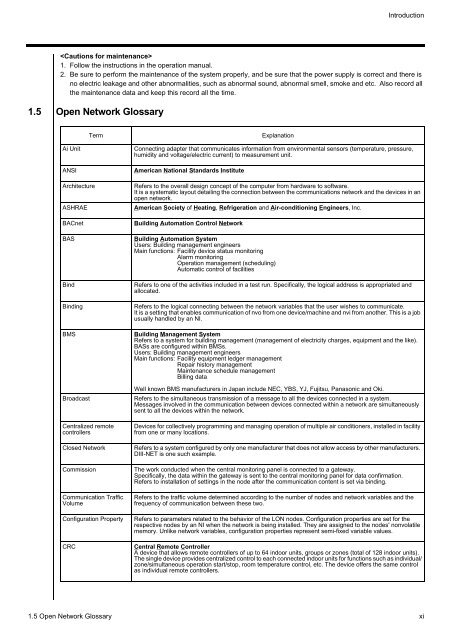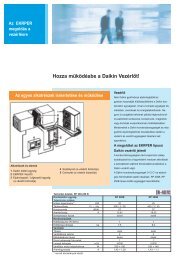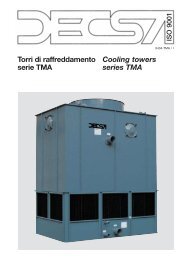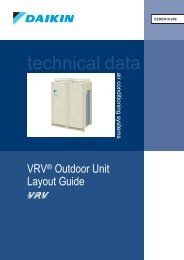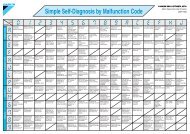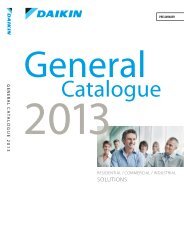1. D-BACS - Daikin
1. D-BACS - Daikin
1. D-BACS - Daikin
Create successful ePaper yourself
Turn your PDF publications into a flip-book with our unique Google optimized e-Paper software.
Introduction<br />
<br />
<strong>1.</strong> Follow the instructions in the operation manual.<br />
2. Be sure to perform the maintenance of the system properly, and be sure that the power supply is correct and there is<br />
no electric leakage and other abnormalities, such as abnormal sound, abnormal smell, smoke and etc. Also record all<br />
the maintenance data and keep this record all the time.<br />
<strong>1.</strong>5 Open Network Glossary<br />
Term Explanation<br />
Ai Unit Connecting adapter that communicates information from environmental sensors (temperature, pressure,<br />
humidity and voltage/electric current) to measurement unit.<br />
ANSI American National Standards Institute<br />
Architecture Refers to the overall design concept of the computer from hardware to software.<br />
It is a systematic layout detailing the connection between the communications network and the devices in an<br />
open network.<br />
ASHRAE American Society of Heating, Refrigeration and Air-conditioning Engineers, Inc.<br />
BACnet Building Automation Control Network<br />
BAS Building Automation System<br />
Users: Building management engineers<br />
Main functions: Facility device status monitoring<br />
Alarm monitoring<br />
Operation management (scheduling)<br />
Automatic control of facilities<br />
Bind Refers to one of the activities included in a test run. Specifically, the logical address is appropriated and<br />
allocated.<br />
Binding Refers to the logical connecting between the network variables that the user wishes to communicate.<br />
It is a setting that enables communication of nvo from one device/machine and nvi from another. This is a job<br />
usually handled by an NI.<br />
BMS Building Management System<br />
Refers to a system for building management (management of electricity charges, equipment and the like).<br />
BASs are configured within BMSs.<br />
Users: Building management engineers<br />
Main functions: Facility equipment ledger management<br />
Repair history management<br />
Maintenance schedule management<br />
Billing data<br />
Well known BMS manufacturers in Japan include NEC, YBS, YJ, Fujitsu, Panasonic and Oki.<br />
Broadcast Refers to the simultaneous transmission of a message to all the devices connected in a system.<br />
Messages involved in the communication between devices connected within a network are simultaneously<br />
sent to all the devices within the network.<br />
Centralized remote<br />
controllers<br />
Devices for collectively programming and managing operation of multiple air conditioners, installed in facility<br />
from one or many locations.<br />
Closed Network Refers to a system configured by only one manufacturer that does not allow access by other manufacturers.<br />
DIII-NET is one such example.<br />
Commission The work conducted when the central monitoring panel is connected to a gateway.<br />
Specifically, the data within the gateway is sent to the central monitoring panel for data confirmation.<br />
Refers to installation of settings in the node after the communication content is set via binding.<br />
Communication Traffic<br />
Volume<br />
Refers to the traffic volume determined according to the number of nodes and network variables and the<br />
frequency of communication between these two.<br />
Configuration Property Refers to parameters related to the behavior of the LON nodes. Configuration properties are set for the<br />
respective nodes by an NI when the network is being installed. They are assigned to the nodes' nonvolatile<br />
memory. Unlike network variables, configuration properties represent semi-fixed variable values.<br />
CRC Central Remote Controller<br />
A device that allows remote controllers of up to 64 indoor units, groups or zones (total of 128 indoor units).<br />
The single device provides centralized control to each connected indoor units for functions such as individual/<br />
zone/simultaneous operation start/stop, room temperature control, etc. The device offers the same control<br />
as individual remote controllers.<br />
<strong>1.</strong>5 Open Network Glossary xi


